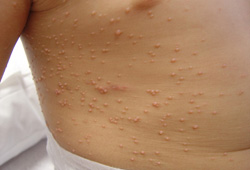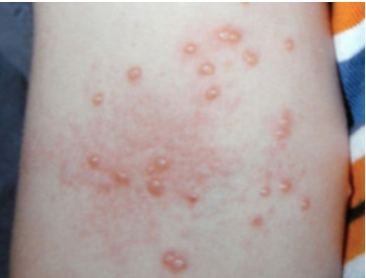History and exam
Key diagnostic factors
common
presence of risk factors
Key risk factors include close or sexual contact with an infected individual, history of atopic dermatitis, history of swimming, HIV infection, and tropical climate.
pearly papule with a central dell
Characteristic appearance of molluscum lesion. More extensive disease of more than 50 lesions may imply immunosuppression.[Figure caption and citation for the preceding image starts]: Extensive molluscum lesions on the flank of a young child; lesions are flesh to pearly coloured with central dellsFrom the collection of Dr Nanette Silverberg [Citation ends].
Other diagnostic factors
common
surrounding erythema
Some of the lesions may be inflamed with surrounding erythema. Lesions may be excoriated and surrounded by dermatitis.[Figure caption and citation for the preceding image starts]: Forearm: pearly papules with a central dell and areas of excoriation and erythema due to inflammationFrom the collection of Dr Nanette Silverberg [Citation ends].
facial or groin distribution of lesions
HIV-infected individuals have larger and more numerous lesions predominantly over the genital region and the face.[20][21][Figure caption and citation for the preceding image starts]: Molluscum contagiosum on the face of an adult, which may be the presenting sign of HIV infection as in this caseMaybury C, Craythorne E. Peri-oral papules. BMJ. 2013 Feb 11;346:f750; used with permission [Citation ends].
pruritus
Is a marker of disability associated with molluscum and results from inflammation.
atopic dermatitis
Presence or absence of coexistent dermatitis, including atopic dermatitis, is important for deciding therapy.
uncommon
sleep disturbance
Marker of disability; associated with extensive molluscum lesions resulting in pruritus.
Risk factors
strong
close contact with an infected individual
Studies have cited close contacts, either siblings or close friends, as being the source of contagion in >40% of patients.[16]
sexual contact with an infected individual
There is clear evidence that the virus can be sexually transmitted.
Sexually transmitted molluscum contagiosum usually involves the anogenital area including the external genital organs, the inguinal folds, the inner thighs, or the suprapubic region.[13]
atopic dermatitis
Both children and adults with atopic dermatitis are more likely to develop infections with molluscum contagiosum due to impaired skin barrier function and immune dysregulation.[8][17]
A 2010 population-based study of nursery school children in Japan found a 1.6-fold increased likelihood of molluscum contagiosum (95% CI 1.00 to 2.68) in children with atopic dermatitis.[18] Other cohort studies have supported this finding.[4]
Resolution of molluscum may take longer in patients with atopic dermatitis.
immunocompromise
The virus is particularly problematic in adults who are immunocompromised, either through disease or due to medications.
The main causes of immunosuppression associated with molluscum contagiosum include HIV infection, solid organ transplants, immunosuppressive therapy (including biological therapy), systemic lupus erythematosus, sarcoidosis, and neoplasia.[13]
Giant nodules of molluscum contagiosum have been described as a first clinical manifestation of HIV infection, including in difficult-to-treat HIV patients, although this is less common among those being treated with antiretroviral therapy.[10]
[Figure caption and citation for the preceding image starts]: Molluscum contagiosum on the face of an adult, which may be the presenting sign of HIV infection as in this caseMaybury C, Craythorne E. Peri-oral papules. BMJ. 2013 Feb 11;346:f750; used with permission [Citation ends].
tropical climate
There seems to be a higher incidence in such areas, and up to 20% of children aged 2 to 11 years living in tropical climates are infected.[11]
weak
swimming
Children who swim have about twice the risk compared with children who do not swim, and frequent swimmers appear to have a higher risk compared with less frequent swimmers.[3][Figure caption and citation for the preceding image starts]: Molluscum on the arm of a child with atopic dermatitis demonstrating pearly papules with a central dell and areas of excoriation and erythema due to inflammationReproduced with permission from dermnetnz.org [Citation ends].
Use of this content is subject to our disclaimer